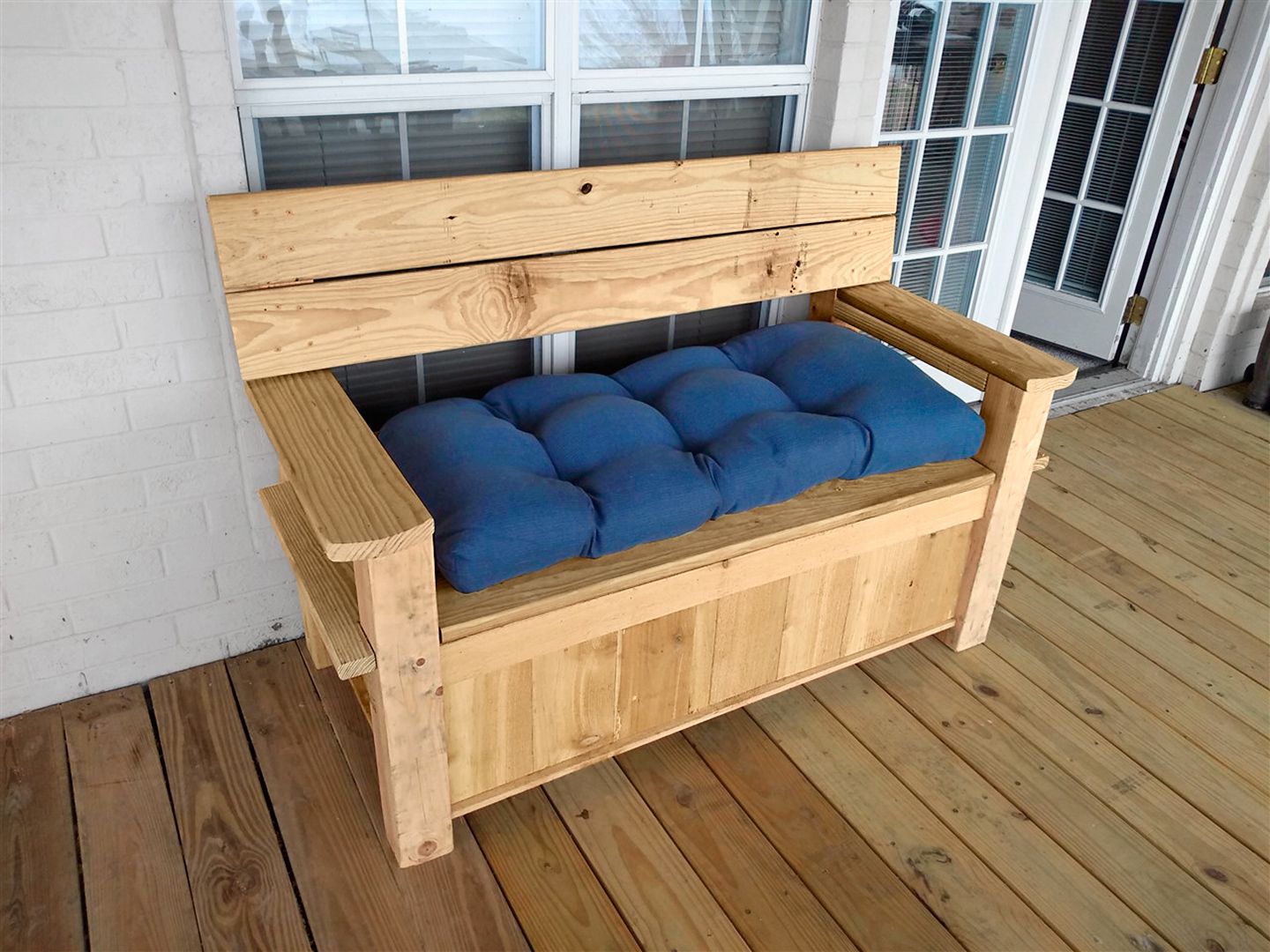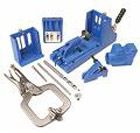Project details
Skill
Cost
Estimated Time
 Circular saw
Circular saw Chop saw
Chop saw Jigsaw
Jigsaw Brad nailer
Brad nailer Cordless drill/driver
Cordless drill/driver Pocket hole jig
Pocket hole jig
To help combat package theft, David Allen built a bench with a hinged seat that conceals a compartment with a magnetic, childproof lock. Leave it open for the delivery person; it locks when the lid is closed. Packages are safely stored until you get home!
Instructions for building the Anti-Porch Pirate Bench
Design by David and Tim Allen
Tools needed:
Circular saw
Chop saw (but can be accomplished with just the circular saw)
Jig saw (if you want to round off the front of the arms)
Staple gun or brad nailer
Drill/driver
Pocket screw jig with pocket screws (if you don’t have one, the $25 jig works fine.)
Step 1
Start by making the legs
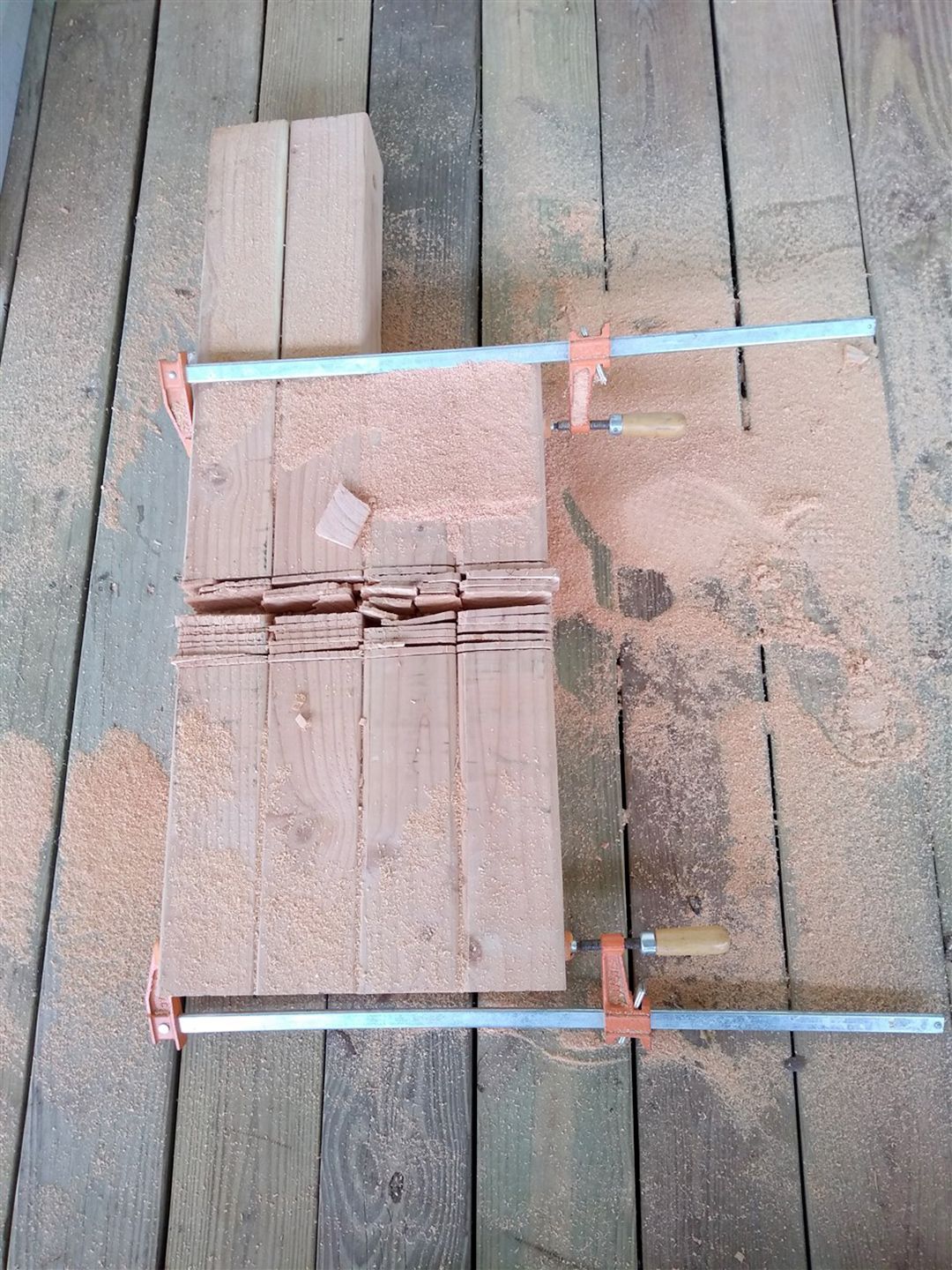
It starts with the corners—a 10′ 4×4 post. Cut off two 24″ pieces for the front legs and cut the remaining piece in half (length not critical). I did the old poor-man’s dado and cut a dado for a 2×4 pressure-treated support. It measures 15″ to the top of the dado.
Cut two 24″ pieces from the 10′ 4×4 post. These are the front legs.
Measure and cut the remaining piece in half (dimension not critical). These are the back legs.
Align all four pieces at one end and clamp.
Mark a dado 11½” up from the aligned edge, then mark it 3½” wide.
Using a circular saw, set the blade depth to 1½” and make repeated cuts through the posts between the two marked lines. Break out the pieces and clean up the bottom of the dado. These pockets will receive the seat frame assembly later.
On the two longer pieces, measure up 24″ on the face (over the dado), then measure down the thickness 1¾” from the top. Cut a taper into the post. This can be done with a circular saw if you mark both sides of the post and make a cut from each side.
Step 2
Make the seat frame
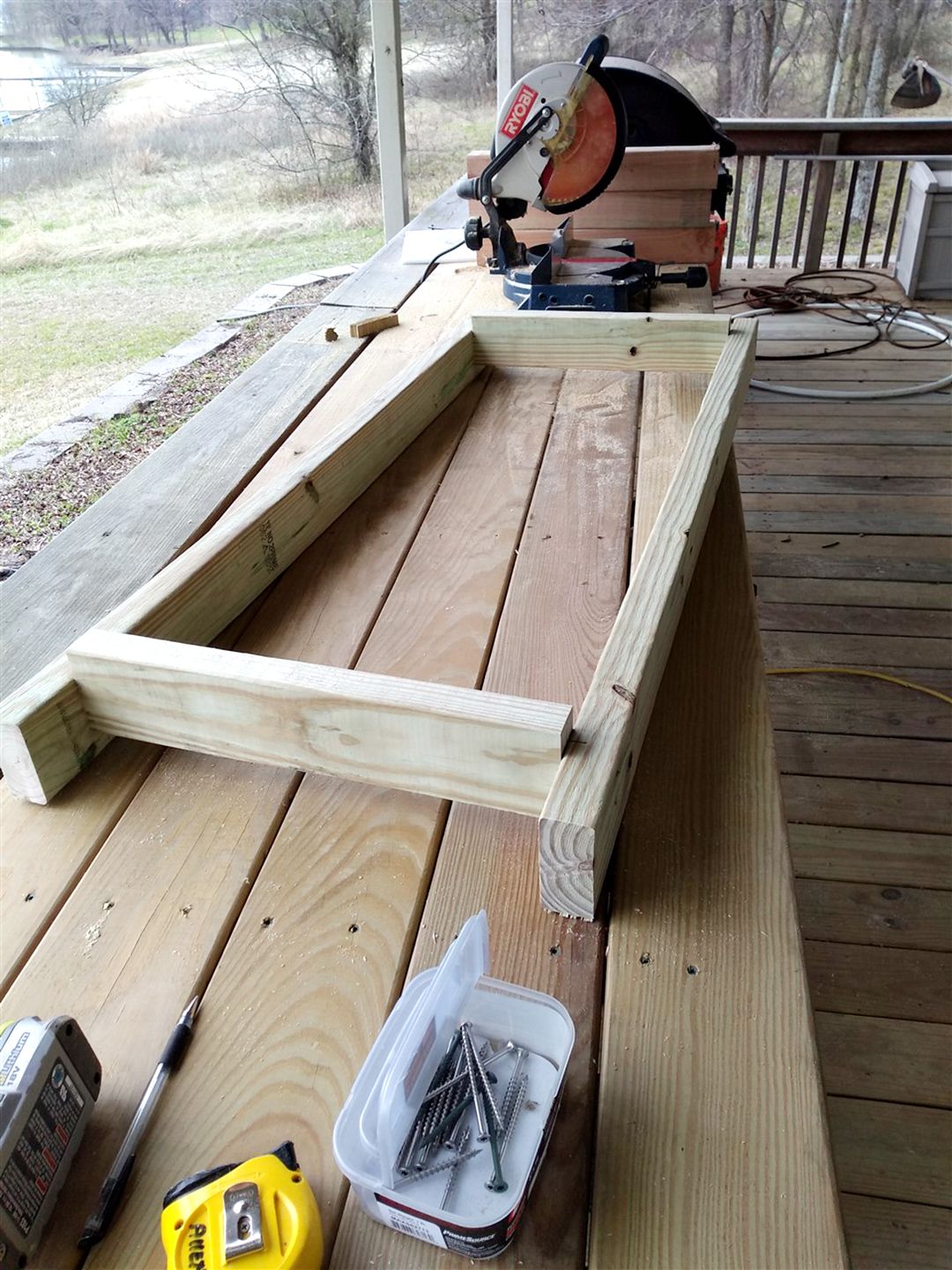
Take two of the pressure-treated 2×4’s. Cut two pieces 51″ and two pieces 17½” (note to make cushion size alterations if necessary). You will build a square frame that will support the seat.
On the face of each 51″ piece mark a line 2¾” in from each end, then mark a line 1″ up from the bottom edge.
Use the 2½” stainless screws to attach the 17½” pieces perpendicular with the outside edge at these lines.
An easy way to accomplish this is to lay the 51″ pieces out on edge. Then lay two of the deck boards flat beside them. Set the 17½” pieces on edge on top of the deck boards and align with the marks. Secure with the screws.
Note the 1″ offset—and don’t do these with pocket screws since they will bear too much weight.
Step 3
Make the seat assembly
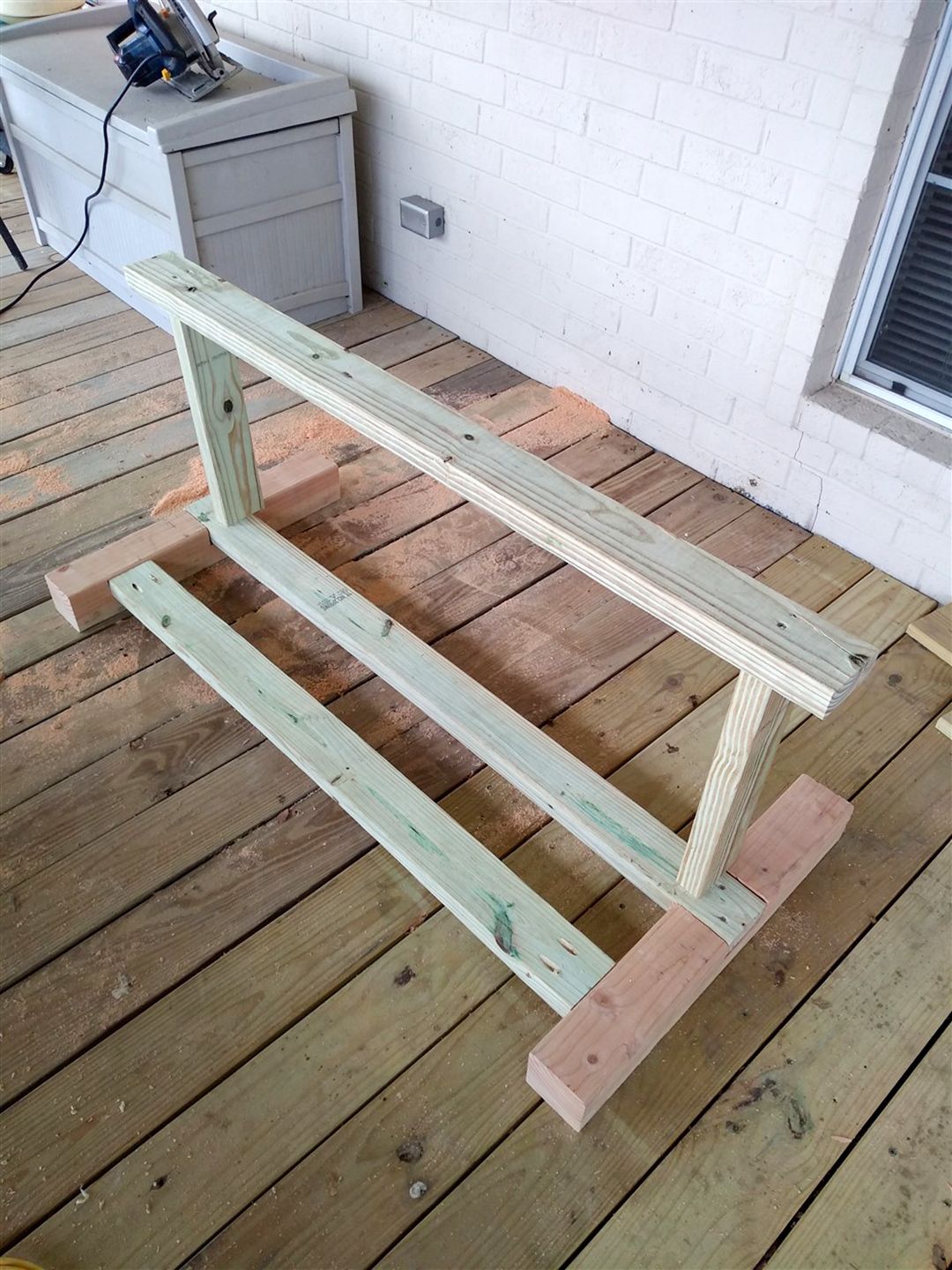
Take two of the pressure-treated 2×4’s and cut two 44″ pieces and two 17½” pieces. Then take the last 2×4 and cut two more 17½” pieces. (Adjust all dimensions for cushion size if necessary.)
Cut two pocket screw holes at the end of each of the four 17½” pieces, and at the end of each of the two 44″ pieces. That’s already 24 pocket holes—the jig will pay for itself!
Lay the two front legs on their back with the dado facing up.
Mark a line 3″ up from the bottom of the legs. This is the alignment mark for the bottom of the 44″ cross pieces.
Set the seat frame into the dado and align each end with the outside of the posts. Secure with 2½” stainless screws.
Then align the bottom of the 44″ cross piece with the mark on the leg and secure with pocket screws (each end).
Step 4
Finish the frame assembly
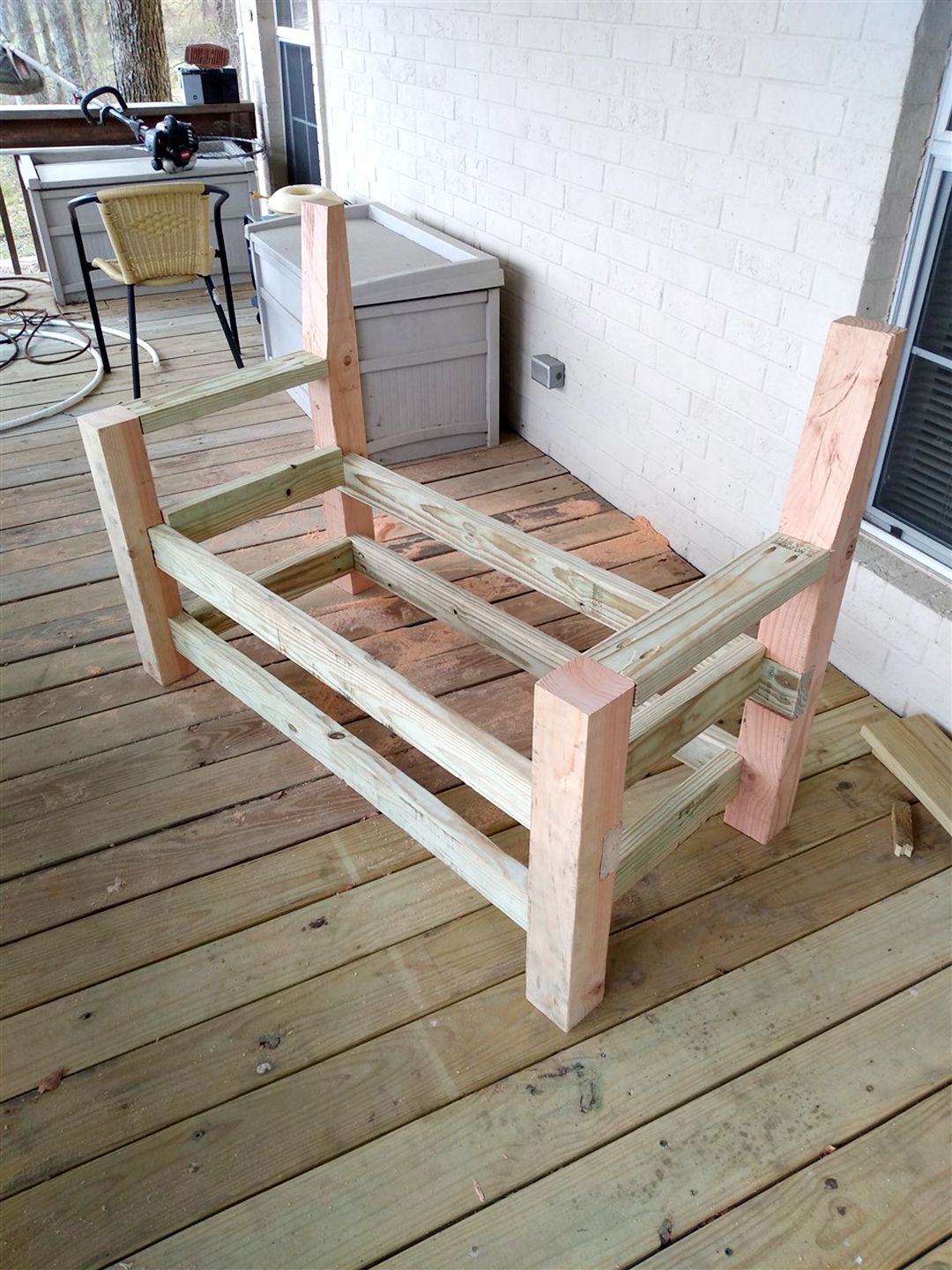
Lay the back legs down with the dado facing up, invert the whole assembly and place the seat frame into the dado. Align at the ends. You can use some of the 17½” pieces as temporary bracing to hold it while you attach with screws.
Stand the assembly upright to finish. Do this on a good flat surface so that the bottoms of all the legs will be even.
Attach two of the 17½” pieces at the same 3″ height as the 44″ pieces measured 2¾” inches in from the outside face of the leg. Note that the face of these should align with the face of the seat frame above. Secure with pocket screws.
Take the last two 17½” pieces and align them with the inside top of the front legs and the start of the taper (at 24″). Secure with pocket screws.
That’s the tough part—the base of the bench!
Step 5
Add the cedar cladding
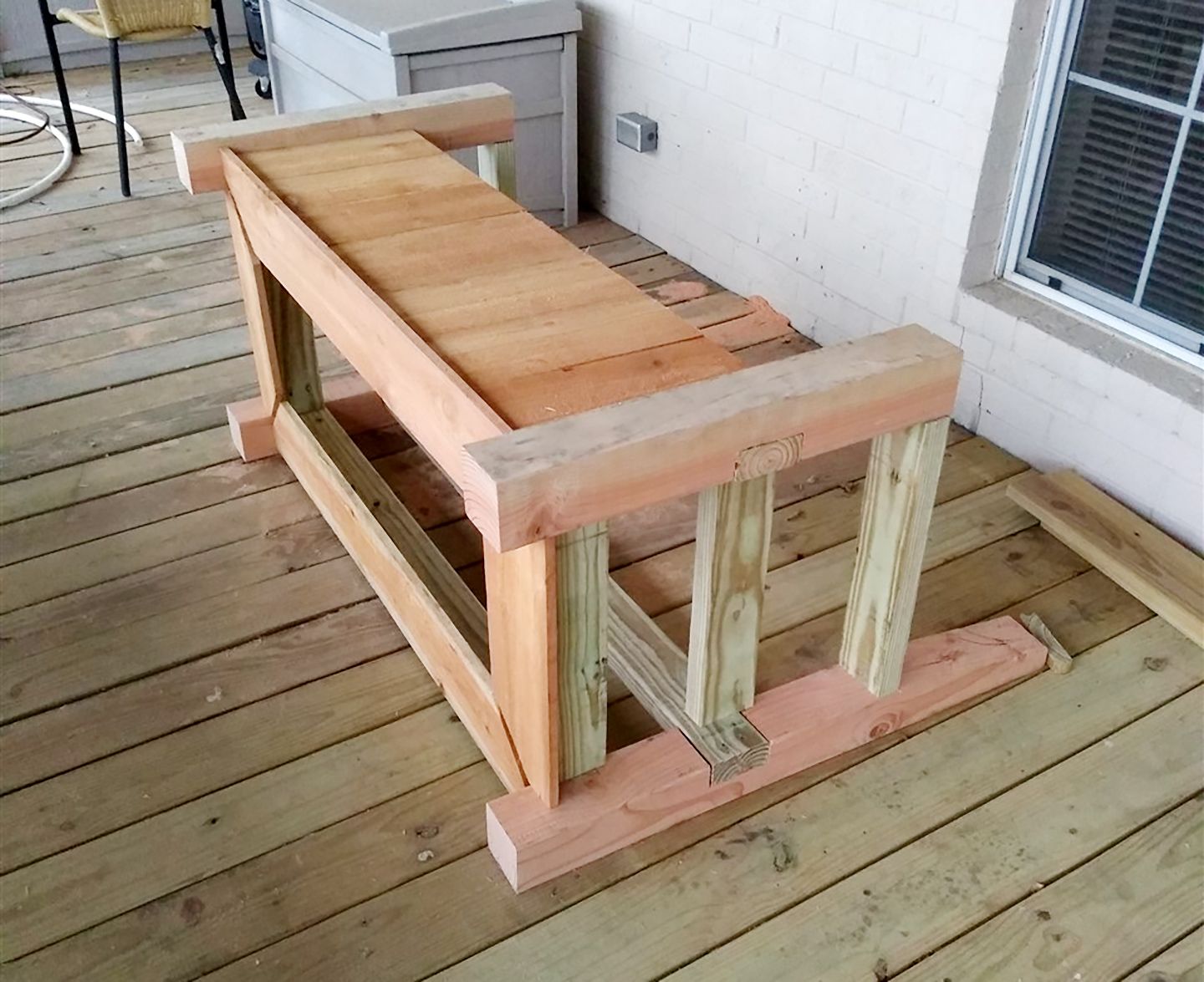
The cedar cladding comes next—mainly because the seat hinges have to go on top of this. All of the cuts mentioned below are from the 6″ cedar fence pickets.
Cut two pieces 44″ and two pieces 17½” (adjust for cushion size)
Cut 45-degree miters at the corners according to this diagram (see below):
Step 6
Cladding diagram
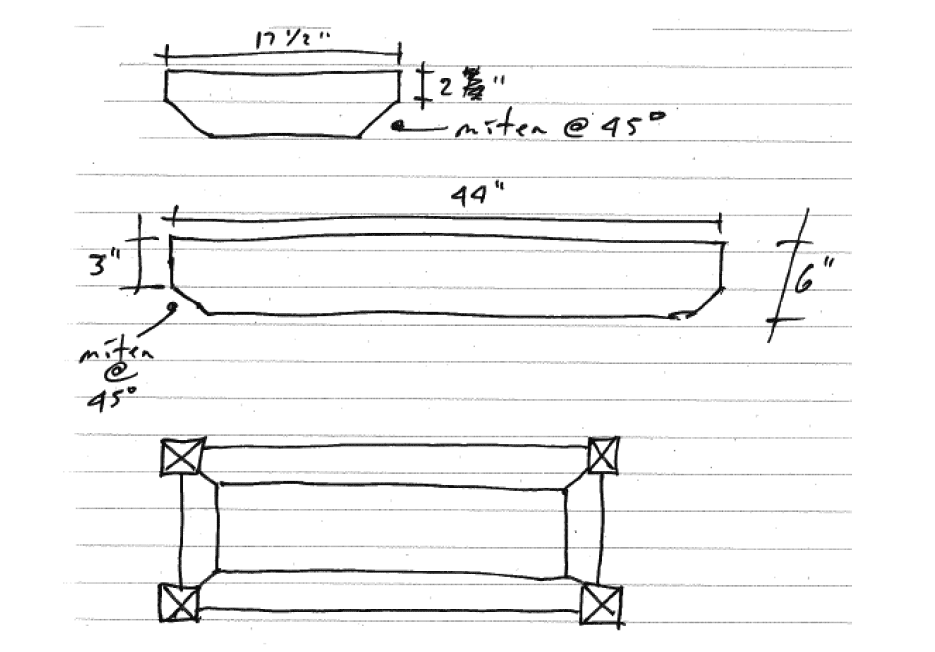
Lay the base back and nail/staple these to the underside of the cross supports. Use a little construction adhesive, too, if you want. (OK—my miters weren’t perfect, but it’s under the bottom where no one will see it.)
Cut a 44″ piece of fence picket and rip in half (approx. 3″). Save one half and cut two 17½” pieces from the other half (cushion size adjust). Cut the rest of the pickets at 13″ lengths.
Nail or staple the 13″ picket pieces all across the front and on both ends making sure to keep them flush to the bottom (mitered) pieces. You will need to rip a picket at each face to make up the leftover gap (it’s not always whole pickets). Then nail the 44″ and 17½” pieces along the top as trim, aligned with the top edge.
Tip the assembly back over onto the front legs. Attach one of the 13″ pickets along the back at each end, then cut the remaining pickets to 12″ lengths and fill in the rest of the back. The back doesn’t get the upper 3″ trim piece like the front and sides. When done, tip the bench back onto the legs in the upright, normal position.
Note—I used construction adhesive and brads to secure all the pickets.
Step 7
Build the seat
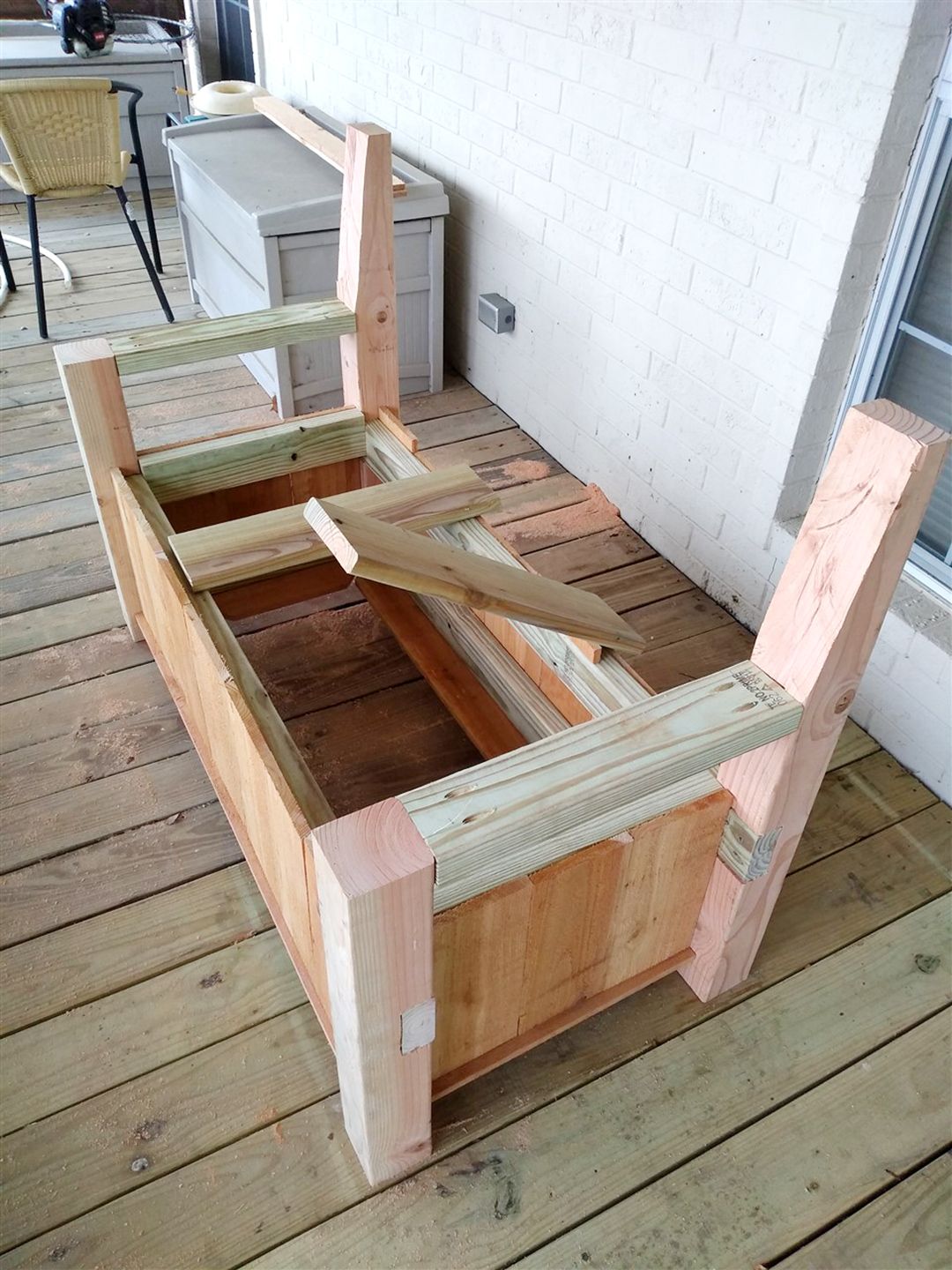
From the deck boards, cut two pieces at 23″ (plus or minus cushion adjustment). These are the seat supports. Lay them across the seat frame so that they are about 10″ in from either end, rest behind the front cedar pickets with a bit of a gap, and overhang at the back. Mark the back for hinges, and install them on the underside of these boards and into the seat frame through the pickets. They just face mount under the seat supports.
Cut five pieces of the deck board at 43½”. Note—you will need to adjust width for cushion and one of these will be the last board in the back, which you will need to rip to size.
The magnetic safety latch will go on the underside of one of these seat boards, however the magnet isn’t strong enough to activate it through the 1″ board. So you will cut a pocket at the end of one of the boards where the lock will be inset.
The best way to do this is to stand one of the seat boards on end and secure. Then set the blade on your circular saw as deep as it will go and make a cut through the end of the board. Then reset the depth to approx. 3/8″ and cut across the board to make the notch. Save the cut piece.
This cut is about halfway through. The board won’t be in the front and the cut will face down, so it won’t show.
From the reminder of the seat board cuts, cut two pieces at 21″. Then cut a 3½” x 3½” notch in one corner of each board.
Lay these between the legs with the interior edge aligned with the inside of the posts. Secure with deck screws.
Step 8
Build the arm supports
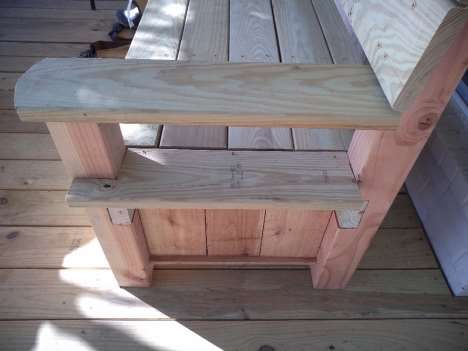
Next cut two deck board pieces at 23″ for arms. If you want to round the arms, draw and cut a radius at one end (I used a flower pot) or you can ease the edge with a 45-degree miter.
Lay these across the top of the arm support and align the inside edge of the arm with the inside edge of the arm support. Secure with construction adhesive and brads (set slightly below the surface). Note not to use screws here as it will be rough on your arms later. This image shows the seat end and arms in place.
With both of these in place, lay in the seat boards and adjust front to back as necessary. You may want the front board to overhang more or just be flush. If it overhangs, miter the ends so that people don’t scrape their calves on them.
Space them any way you like, and note that you will need to rip the back board to width (whatever that comes out to be) even though it’s OK if it’s extra wide. It won’t interfere with the hinge.
MAKE SURE that the seat board with the cut inset is the second board—inset facing down—and you can put it at either end.
Secure all the seat boards to the hinged supports with deck screws. Make sure not to screw the ends of the board to the seat frame or it won’t open.
From the last two deck boards, cut two 55″ pieces (or whatever cushion adjustments you may need, or think looks nice). Secure these across the back legs on the mitered face.
The image above shows the seat end and arms in place.
Step 9
Add the childproof lock
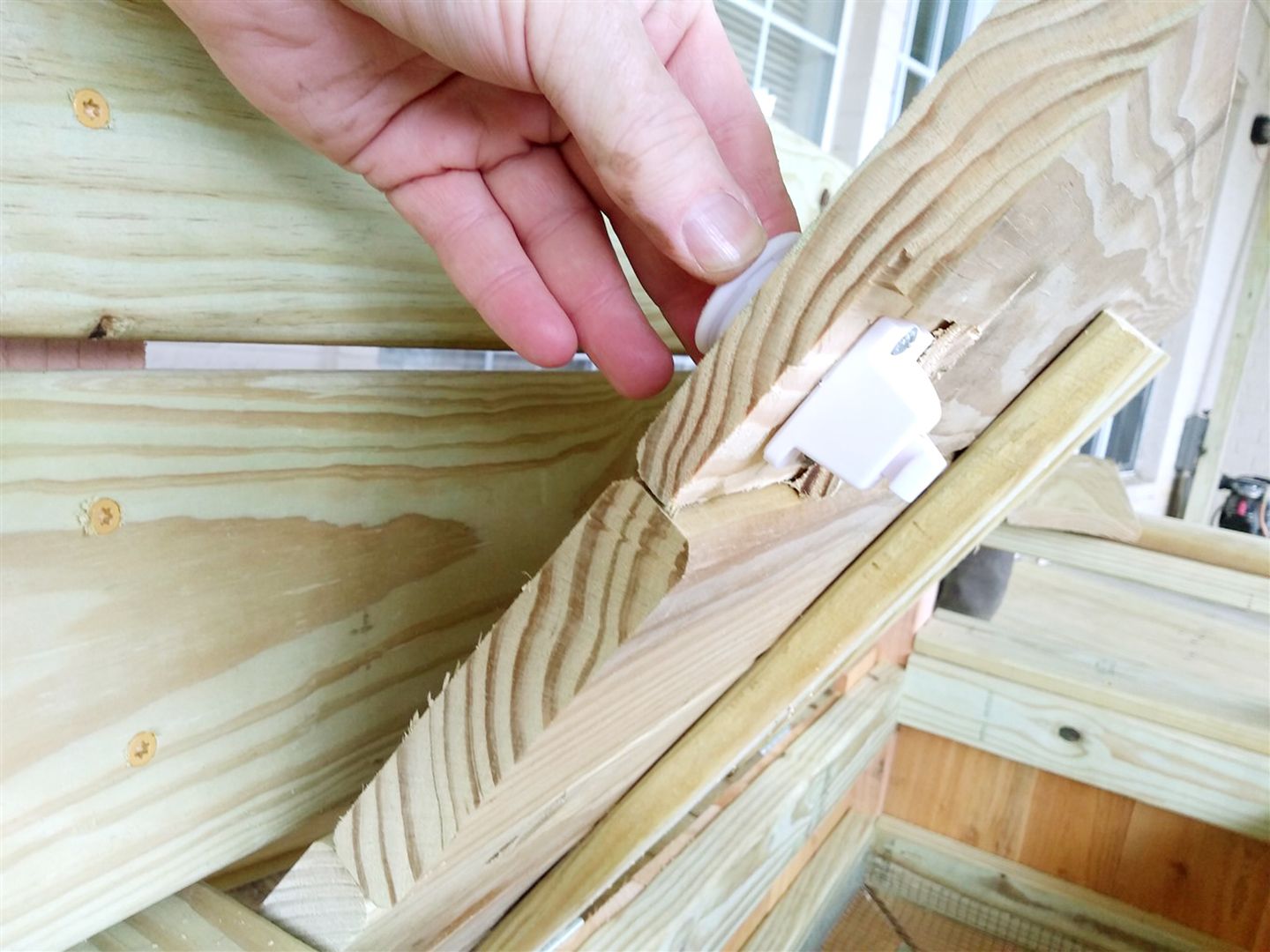
This unassuming little plastic lock is designed to keep a two-year-old from pulling open a cabinet door—and both are stronger than you might suspect.
Note—the design is meant to deter porch pirates and is not a guarantee that no one can get in here. The assumption is that thieves grab exposed packages that are an easy target, but even a small barrier will send them on their way. First we hope that they don’t realize the packages are inside the bench. Next, we hope that they aren’t going to try to figure out how this is latched and come up with some way to defeat the mechanism. Since nothing shows, for all they know there’s a steel lock holding all the boards solidly. A couple of tugs and it will seem solidly locked. And if they flip it over, I guarantee they won’t get past the wire mesh bottom (which you will install in the next step). Plus the lock still won’t open. So while it’s a good bet that things will remain secured, I can’t guarantee that no one will ever get in here. If you know the type and location of the lock, it is possible to jimmy it with a coat hanger. Ask any three-year-old (by then they’ve figured these out). But only you will know exactly where that lock is. Enough of a disclaimer.
And as far as that goes, you could accomplish this with a piece of spring steel and latch, with a tiny hole where you poke in a steel rod and press the latch in. Or a piece of string out the back that pulls a latch back. Any type of remotely operated yet hidden latch is fine.
So far you’ve made a pretty nice bench, and if the seat didn’t hinge it would work perfectly well as-is. However, you want this as a storage unit for deliveries. Right now the lid lifts up but you need a bottom and a lock, so you need to install these two things.
CAUTION—Install the lock first while you can still reach into the compartment from the bottom.
Set the bench up on one end with the inset part of the seat board at the top. With the lid closed, use some glue and brads to secure the inset scrap piece (you cut before) against the side support and up flush to the underside of the seat inset.
This will be the base onto which you secure the lock.
Follow the instructions supplied with the lock and install into the inset as shown. The initial install is with the supplied double-stick tape, then secured with supplied screws. You will have to reach through the bottom of the bench to reach the underside of the seat and put the lock in place. The set I used had a guide for installing to make sure everything went in correctly, which made it very easy. Be sure to secure with the screws since this may be outdoors and subject to moisture. Adjust the lock as necessary so that it will latch when closed, and unlock with the magnet.
As you can see in the images below, the latch goes into the inset and the magnet can trigger it from above. My inset didn’t go all the way across the board, but it’s easier if it does. Mine could also be a little thinner, too.
Put the bench back in the horizontal position and try the latch several times before continuing. Once you put the bottom in it will not be possible to reach the lock mechanism with the lid closed since it locks automatically. The brand I got will also lock in the open position.
Are you sure the latch is working correctly? Then move on.
Step 10
Add the storage basket
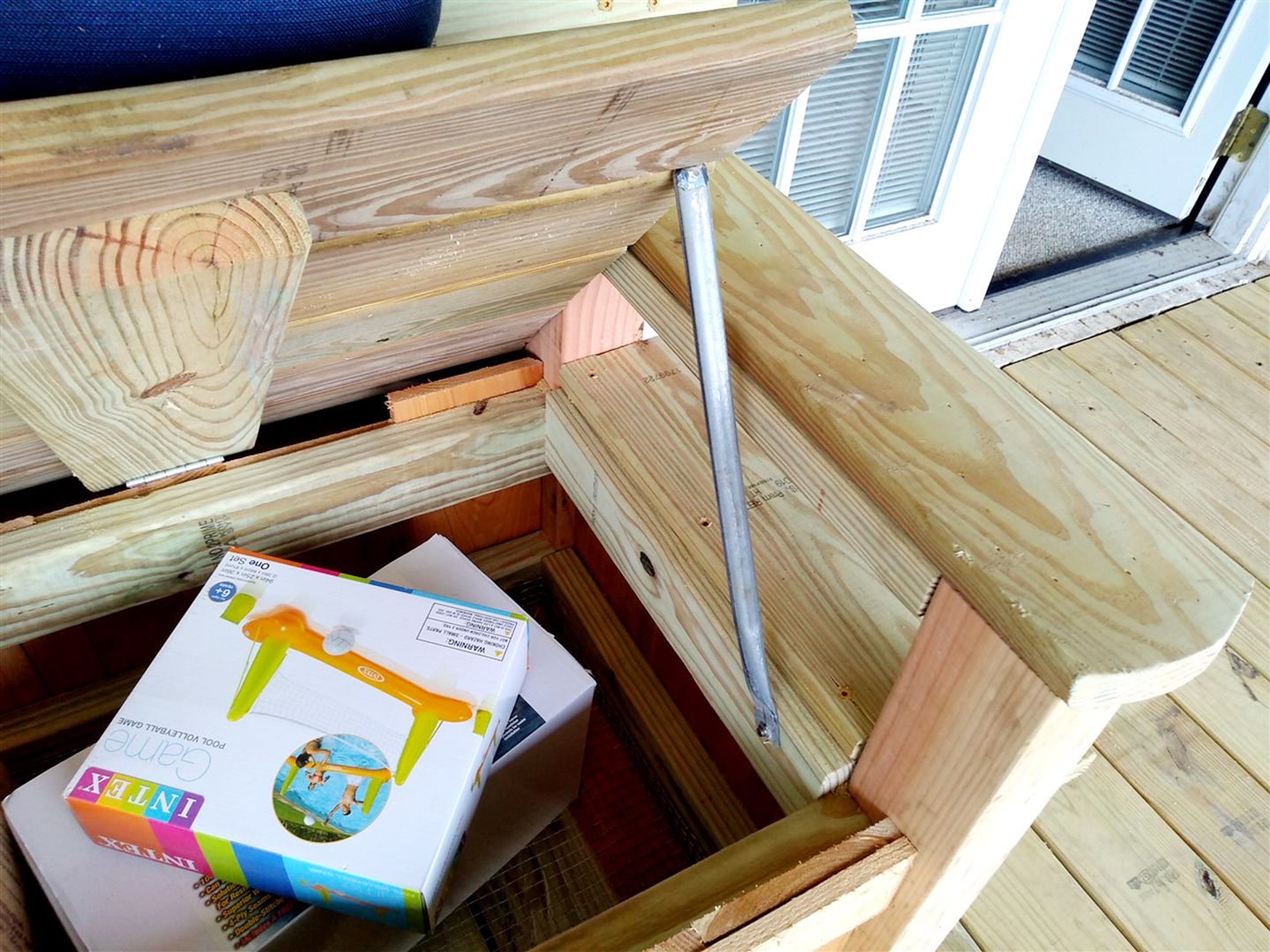
The measurements of the bottom are approximately 17½” x 43¼” – but go ahead and measure to make sure and accommodate any changes you have made for the cushion.
Cut a piece of wire mesh about 4″ longer in each dimension – so for the standard 17½” x 43¼” the wire would be about 22″ x 47″. Then cut a 2″ notch out of each corner. Lay a board along the wire at the inside of the notch and bend the wire up at 90 degrees to make a basket the size of the bottom.
Slip this basket down inside the bench—tap into the corners with a scrap of wood if necessary so that it lays flat. Then staple the wire to the face of the lower seat support. This puts the bearing forces on the 2×4’s instead of the fence slats.
Step 11
Final touches
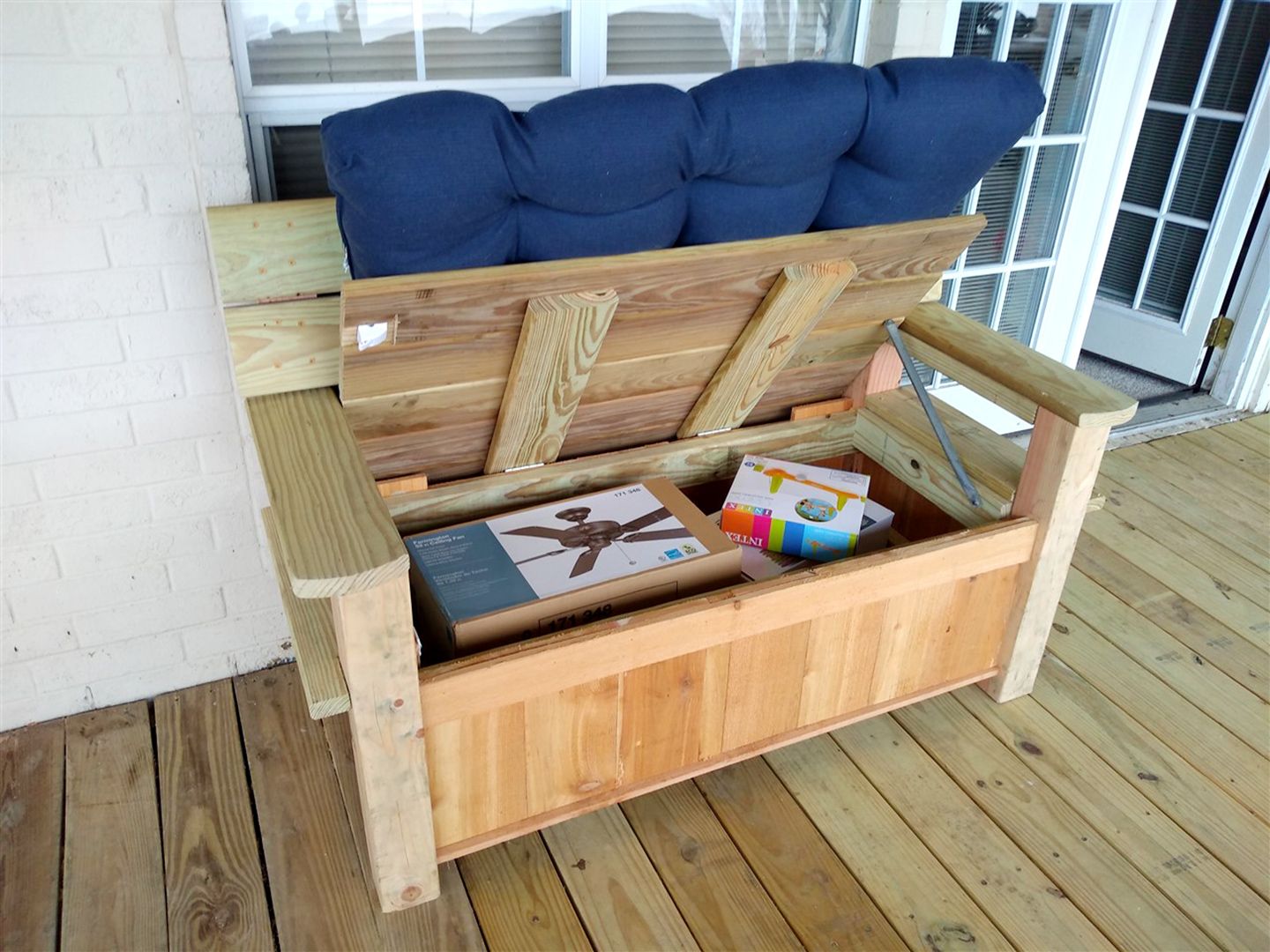
As a final touch, I added a metal seat support. But this could be a wooden slat or you could even use a mechanical soft-close lid support. It just needs to be something that can hold the lid up until the courier drops off your package, then allow the lid to close and lock. With this, you lift slightly and the support drops down out of the way.
I also considered putting a ½” x 4″ strip of plywood in the center and hinging it to the underside of the seat, then taping a sign on it that says something like ‘Put Deliveries Inside And Lower Seat.’ It would fold up flat against the bottom of the seat, but when open it would sit on the edge of the seat frame to support the lid. Be inventive; use what you’ve got lying around.
When you are expecting a delivery, you can prop the seat open and put a sign on the door. Other times you could put a piece of cardboard over the latch to keep it from locking—then then the delivery person lifts the seat the cardboard falls away and the latch is operational again. It’ll hold a lot of stuff!
Then you unlock and open with the magnet placed over the secret location.
